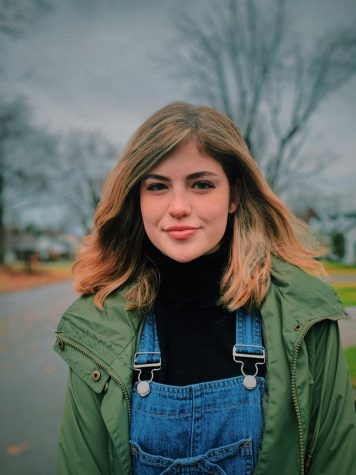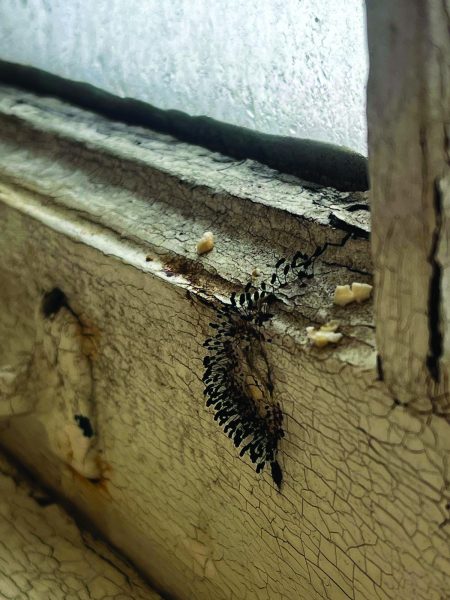Allegheny makes changes to classrooms to comply with COVID-19 safety guidelines, professors address technological and logistical challenges
To prepare for the fall semester, Allegheny made significant changes to how students would learn — whether they decided to return to campus or take classes remotely.
President Hilary Link outlined how the college was following the Center of Disease Control’s guidelines, including a mask mandate and physical distancing requirements.
“In classrooms, everyone will be masked,” Link said. “Faculty and other students have the right to send another student out of the classroom if they’re not wearing a mask because it’s putting not just themselves or the people around them at risk, but the whole community.”
In accordance with the CDC guidelines, every classroom in use has been arranged such that there is at least six feet of distance between each person.
“We literally went classroom to classroom this summer spacing out (six feet of distance between desks) with a measuring tape,” Link said. “So we’ve taken this really seriously.”
According to Dean of Curriculum and Registrar Ian Binnington, in order for classrooms to be able to be in use this semester, the college had to test whether or not each academic building had proper ventilation.
“We’ve been working with the Physical Plant and the Allegheny College Health Agency, and we’ve been looking at the CDC’s and other professional organizations’ standards for airflow,” Binnington said. “The big issue is moving the air from the inside to the outside. You don’t want the air sitting there, you want it moving.”
The buildings that did not have proper ventilation had to be taken out of commission for the fall semester, including Oddfellows Hall, Ruter Hall, and the second floor of Alden Hall.
Binnington explained that this resulted in around 80-100 classes being moved to academic buildings with acceptable ventilation or other non-traditional spaces.
“We have classes in the Henderson Campus Center, Tippie Alumni Center, Shultz East Alcove, Pelletier Library and I think we have a couple dance and movement classes in the Wise Sports and Fitness Center,” Binnington clarified.
Link commended the Allegheny faculty for being flexible with the physical modifications of classes and building changes.
“In many cases, (professors) are not teaching in the room that they may have been teaching in for the past 15 years,” Link said. “To accommodate the students in their class, they may have had to move to a completely different space.”
Beyond physical changes, professors have had to face the challenge of incorporating new technology into their teaching to provide students with the option of learning remotely.
Furthermore, students who test positive for COVID-19 will need to learn remotely during the two-week isolation period.
“COVID-19, for better or for worse, has forced all of us to pivot and use technology in ways that we never thought,” Link said.
Despite the difficulties of teaching online and in person simultaneously, Link explained that she and the faculty had a positive outlook about what changes the new technology would bring for the future of education at Allegheny.
“Our hope is that, even in the midst of what we know (are) going to be logistical challenges, that the core of what students come to Allegheny for, which is to be mentored by and inspired by our amazing faculty, not only does not get diminished but actually gets improved,” Link said.
Across departments, the faculty Link praised have had to discover new teaching methods to optimize student experience in the face of this semester’s challenges. One of the consistent concerns is how to best balance instruction and attention between remote students and in-person students.
“Learning to balance the remote and in-person students I think is going to be the hardest part (of the semester),” said Chemistry Department Chair Timothy Chapp.
History Department Chair Judson Herrman plans to implement a strategy in his classes that involves appointing an in-person student to monitor the chat box for any questions that the remote students have during instruction time.
Assistant Professor of Marketing and Neuromarketing Gaia Rancati had a similar approach to teaching remote students and involving them during class time.
“We need to find a different way to (connect) with (remote) students,” Rancati said. “So I have decided to (assign) a moderator in all my classes that is essentially going to be a bridge between me and all students.”
The main purpose of the moderator in Rancati’s class is to collect anonymous questions about the material for her to answer via a recording after the class to make students feel more comfortable.
“When you are in a new platform, whether you’re in-person, online, hybrid and so on, sometimes you don’t want to ask a question because nobody else is asking (it),” Rancati said. “So (by collecting questions) everybody will feel free to ask me a number of questions and I will never know (who asked what).”
Some professors, like Chapp, had to alter classes in order to accommodate remote students who could not conduct research or have access to a lab.
“So (in) our (senior) comp experience we obviously have some students who are completely remote for this semester and some that are in-person, so we reformatted our comp guidelines in the style of a grant proposal,” Chapp explained. “By switching to a grant proposal model, what it allows us to do is evenly evaluate students whether they are remote or in person.”
English Department Chair Matthew Ferrence, who is teaching entirely remotely this semester, noted that developing a personal relationship with students could be a challenge.
“We’ll have to adjust how we get to know each other personally, even though our interface is through a screen,” Ferrence said. “One of my biggest concerns is to make sure we’re still hanging out and talking, and that we get to know each other well.”
Even with the various challenges, professors expressed hope that teaching classes in a new way this semester will produce positive outcomes.
Herrman, who is hosting both online and in-person office hours, proposed that having both options might make students more inclined to attend office hours.
“On some level, I hope that (having that option) would increase students availing themselves of office hours,” Herrman said. “Maybe it would increase accessibility.”
Despite the unprecedented circumstances, Rancati remained positive about the future of the semester, as well as the future of educating.
“I believe that this way of teaching will really bring us out of our comfort zone and something else will come out (of it) and we will learn how to be better professors,” Rancati said. “I really hope to give the students the quality they deserve.”

Alana Sabol is a junior from Erie, Pennsylvania. She is an Environmental Science and Sustainability major with a Journalism minor. This is her second year...



